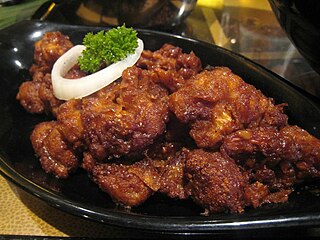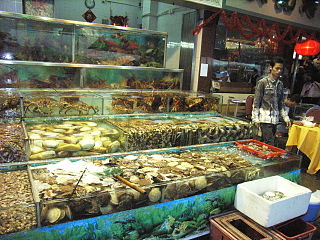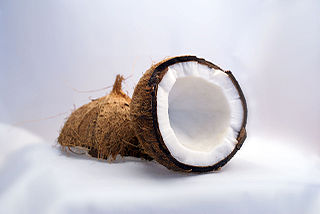See also
| This disambiguation page lists articles associated with the title Chinese restaurant. If an internal link led you here, you may wish to change the link to point directly to the intended article. |
A Chinese restaurant is a food establishment serving Chinese cuisine. The term can also refer to:
| This disambiguation page lists articles associated with the title Chinese restaurant. If an internal link led you here, you may wish to change the link to point directly to the intended article. |

American Chinese cuisine is a style of Chinese cuisine developed by Chinese Americans. The dishes served in many North American Chinese restaurants are adapted to American tastes and often differ significantly from those found in China.

Cuisine of Chinese Muslims is the cuisine of the Hui and other Muslims living in China such as Bonan, Dongxiang, Salar and Uyghurs as well as Dungans of Central Asia.

Cantonese cuisine or more accurately, Guangdong cuisine, also known as Yue cuisine (粵菜) refers to the cuisine of the Guangdong province of China. "Cantonese" specifically refers to only Guangzhou or the language known as Cantonese associated with it, but people generally refer to "Cantonese cuisine" to all the cooking styles of the speakers of Yue Chinese languages from within Guangdong. The Teochew cuisine and Hakka cuisine of Guangdong are considered their own styles, as is neighboring Guangxi's cuisine despite also being considered culturally Cantonese. It is one of the Eight Culinary Traditions of Chinese cuisine. Its prominence outside China is due to the large number of Cantonese emigrants. Chefs trained in Cantonese cuisine are highly sought after throughout China. Until recently, most Chinese restaurants in the West served largely Cantonese dishes.

Fusion cuisine is cuisine that combines elements of different culinary traditions that originate from different countries, regions, or cultures. Cuisines of this type are not categorized according to any one particular cuisine style and have played a part in innovations of many contemporary restaurant cuisines since the 1970s.

Hakka cuisine, is the cooking style of the Hakka people, who may also be found in other parts of Taiwan and in countries with significant overseas Hakka communities. There are numerous restaurants in Taiwan, Hong Kong, Indonesia, Malaysia, Singapore and Thailand serving Hakka cuisine. Hakka cuisine was listed in 2014 on the first Hong Kong Inventory of Intangible Cultural Heritage.

General Tso's chicken is a sweet deep-fried chicken dish that is served in North American Chinese restaurants. The dish is named after Zuo Zongtang, a Qing dynasty statesman and military leader, although there is no recorded connection to him nor is the dish known in Hunan, Zuo's home province.

Hong Kong cuisine is mainly influenced by Cantonese cuisine, European cuisines and non-Cantonese Chinese cuisines, as well as Japanese, Korean and Southeast Asian cuisines, due to Hong Kong's past as a British colony and a long history of being an international port of commerce. From the roadside stalls to the most upscale restaurants, Hong Kong provides an unlimited variety of food and dining in every class. Complex combinations and international gourmet expertise have given Hong Kong the reputable labels of "Gourmet Paradise" and "World's Fair of Food".

Canadian Chinese cuisine is a popular style of Canadian cooking exclusive to take-out and dine-in eateries found across Canada. It was the first form of commercially available Chinese food in Canada. This cooking style was invented by early Cantonese immigrants who adapted traditional Chinese recipes to Western tastes and the available ingredients. This cuisine developed in a similar process to American Chinese cuisine.

Korean Chinese cuisine is a hybrid cuisine developed by the ethnic Chinese and the ethnic Koreans in South Korea. Derived from Chinese cuisine, Korean Chinese cuisine consists of unique dishes with Korean flavors and ingredients. Most Korean Chinese restaurants in and outside South Korea are owned and operated by Koreans rather than ethnic Chinese. In South Korea, the food is usually delivered. In the United States, only Mandarin-style Chinese restaurants are familiar with Korean Chinese cuisine, as it is a hybrid of Korean and Mandarin Chinese cuisines; Szechuan-style restaurants largely do not serve this type of cuisine.

A Cantonese restaurant is a type of Chinese restaurant that originated in Southern China. This style of restaurant has rapidly become common in Hong Kong.

Indian Chinese cuisine or Sino-Indian cuisine and also Chindian cuisine, is the adaptation of Chinese seasoning and cooking techniques to Indian tastes through a larger offering to also include vegetarian dishes. The Indian-style Chinese cuisine is said to have been developed by the small Chinese community that has lived in Kolkata for over a century. Today, Chinese food is an integral part of the Indian culinary scene. It is also enjoyed by overseas Indian communities in North America and Great Britain.

Japanese Chinese cuisine or Chūka is a style of Japanese cuisine served by nominally Chinese restaurants popularized in Japan in the late 19th century and more recent times. There is much confusion as both Japanese and Chinese reject that this food is the pure form of their own cuisine, however, it is clear this food is found primarily in Japan, though now it is re-popularized throughout Asia from Japan as "Japanese cuisine". This style of food is again different from modern Chinatown Chinese food in Japan, e.g. Yokohama Chinatown. The Shippoku style of cooking displays heavy influence from Chinese cuisine.

Chinese imperial cuisine is derived from a variety of cooking styles of the regions in China, mainly from the cuisines of Shandong and Jiangsu provinces. The style originated from various Emperors' Kitchen and the Empress Dowagers' Kitchen, and it is similar to Beijing cuisine which it heavily influenced. Imperial cuisine was served mainly to the emperors, their empresses and concubines, and the imperial family. The characteristics of the Chinese imperial cuisine are the elaborate cooking methods and the strict selection of raw materials, which are often extremely expensive, rare or complicated in preparation. Visual presentation is also very important, so the colour and the shape of the dish must be carefully arranged. The most famous Chinese imperial cuisine restaurants are both located in Beijing: Fang Shan in Beihai Park and Ting Li Ting in the Summer Palace.

Chifa is culinary tradition based on Chinese Cantonese elements fused with traditional Peruvian ingredients and traditions. Though originating in Peru, the Chifa tradition has spread to neighboring countries like Ecuador, Chile and Bolivia. Chinese immigrants came to Peru mainly from the southern province of Guangdong and particularly its capital city Guangzhou in the late 19th and early 20th centuries. They settled for the most part in the coast of Peru and the capital city of Lima. The term chifa is also used to describe a restaurant where this type of food is served. Chinese-Peruvian food has become one of the most popular types of food in Peru; The first Chinese–Peruvian fusion restaurants were opened in Lima in around 1920 in Lima's China town ; there are thousands of Chifa restaurants across all districts of Lima and many more throughout other cities of Peru, with sometimes multiple independent restaurants operating in close proximity on a single city block.

Pakistani Chinese cuisine comprises the styles and variations of Chinese cuisine that are cooked and consumed in Pakistan. Chinese migrants to Pakistan have developed a distinct Pakistani-style Chinese cuisine.

A Chinese restaurant is an establishment that serves a Chinese cuisine. Most of them are in the Cantonese style, due to the history of the Chinese diaspora and adapted to local taste preferences, as in the American Chinese cuisine and Canadian Chinese cuisine. The Chinese restaurants in the Netherlands usually combine Cantonese and Indonesian meals on their menu. Chinese takeouts or Chinese takeaways are terms to describe the act of ordering the meal(s) with the intent to eat the food at another location, such as at work or home. It can be found either as a service option of eat-in establishments or as separate establishments.

The cuisine of Nauru is the traditional cuisine of the island state on the Pacific Ocean. Due to the diversity of the country's inhabitants, the cuisine is highly diverse.